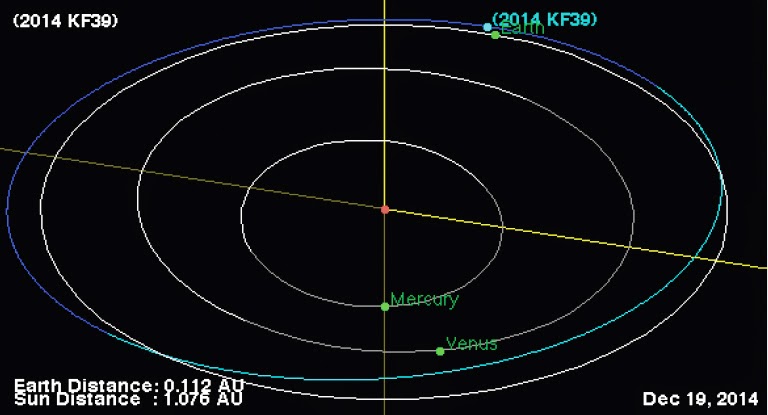Asteroid 2001 XY10 passed by the Earth at a distance of about 18 540 000
km (48.22 times the average distance between the Earth and the
Moon, or 12% of the average distance between the Sun and the Earth), at
about 11.00 am GMT on Monday 22 December 2014. There was no
danger of the asteroid hitting us, though were it to do so it would have
presented a serious threat. 2001 XY10 has an estimated
equivalent diameter of 260-820 m (i.e. it is estimated that a spherical
object with the same volume would be 260-820 m in diameter), and an
object of this size would be predicted to be capable of passing through
the Earth's atmosphere relatively intact, impacting the ground with an
energy equivalent to about 600- 20 000 megatons of TNT (roughly 35 000-1 175 000
times the energy of the Hiroshima bomb). Such an event
would result in a crater between 4 and 12 km across, cause devastation
on a global scale and would have the potential to affect the climate
globally for decades or even centuries after the impact event.
The calculated orbit of 2001 XY10. JPL Small Body Database Browser.
2001 XY10 was discovered on 12 November 2001 by the Massachusetts Institute of Technology's Lincoln Near Earth Asteroid Research Laboratory
in Socorro, New Mexico. The designation 2001 XY10 implies that it was
the 274th asteroid (asteroid Y10) discovered in the first half of November 2001 (period 2001 X).
2001 XY10 has a 297 day orbital period, with an elliptical orbit tilted
at an angle of 31° to the plain of the Solar System which takes in to
0.53 AU from the Sun (53% of the distance at which the Earth orbits the
Sun, considerably inside the orbit of Venus) and out to 1.21 AU (21% further away from the Sun than the Earth).
This means that close encounters between the asteroid and Earth are
fairly common, with the last thought to have happened in May 2011 and
the next predicted in July 2015. Although it does cross the Earth's
orbit and is briefly further from the Sun on each cycle, 2001 XY10
spends most of its time closer to the Sun than we are, and is therefore
classified as an Aten Group Asteroid.
See also...
Asteroid 2014 KF39 passed by the Earth at a distance of 16 780 000 km
(43.68 times the average distance between the Earth and the Moon, or
11.2
%
of the average distance between the Earth and the Sun)...
Asteroid 2014 WM365 passed by the Earth at a distance of 8 165 000 km
(21.26 times the average distance between the Earth and the Moon, or 5.4
%
of the average distance between the Earth and the Sun)...
Asteroid 2014 WD497 passed by the Earth at a distance of 6 144 000 km
(15.95 times the average distance between the Earth and the Moon, or 4.1
%
of the average distance between the Earth and the Sun)...
Follow Sciency Thoughts on Facebook.




